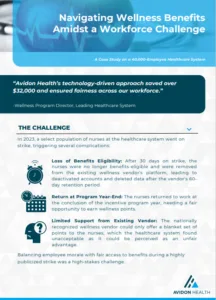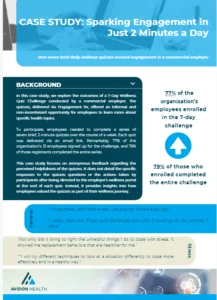Debunking Myths About Behavior Modification
If you’re not a health coach, you might be skeptical about behavior modification. Maybe you’ve heard that it’s only effective for a short time, or perhaps you’ve seen failed attempts at long-term change and wonder if it’s really worth the effort. As professionals deeply involved in helping people achieve lasting health improvements, we’ve seen firsthand how behavior modification can drive real, sustainable change. It works—and not just for health coaches. In fact, anyone looking to influence positive behaviors—whether in wellness programs, employee engagement, or personal growth—can benefit from understanding how this approach actually works.
Here’s why behavior modification is more than just theory and why it can be a powerful tool, no matter your background.
Myth 1: “Behavior Modification Is Only Temporary”
You might think that behavior change only lasts while someone is intensely focused, and then old habits creep back. This myth is based on incomplete approaches that don’t include ongoing support. But when behavior change is reinforced, results last long beyond the initial burst of motivation.
A study published in the American Journal of Public Health found that long-term success in behavior modification is linked to continuous engagement and structured follow-ups, rather than a one-time effort. Programs that use digital tools and regular check-ins saw individuals maintain changes for over a year.
Real-Life Experience: We’ve seen clients stay engaged for months and even years when their progress is tracked and celebrated. Whether it’s encouraging an employee to adopt new wellness habits or guiding a client through weight loss, long-term behavior change comes down to consistent reinforcement. This is why digital coaching platforms, like ours, integrate these principles and keep users on track with personalized nudges.
Myth 2: “People Need Radical Changes for Behavior Modification to Work”
If you believe that behavior change requires a complete overhaul of someone’s life, you’re not alone. This is a common misconception, but it’s also the reason many people give up before they really get started. The truth is, incremental changes are far more effective than drastic shifts.
The Transtheoretical Model (also known as the Stages of Change Model) highlights that people go through small, deliberate stages of change. A review published in the Journal of Behavioral Medicine showed that small steps, like gradually increasing physical activity or cutting out one unhealthy habit, result in more sustainable progress.
Real-Life Experience: We have guided hundreds of thousands of individuals through behavior change programs, and the most successful stories always start with tiny, manageable actions. One client who began by logging her mood each day a day, eventually adopted better mental health patterns over months. It wasn’t about a drastic change—it was about building consistent habits. In a workplace setting, the same can be done by encouraging employees to make small adjustments, such as taking breaks to stretch or drink more water throughout the day.
Myth 3: “Only Motivated People Can Change Their Behavior”
 You might think that behavior modification only works for highly motivated people—those who already have the drive to make changes. This couldn’t be further from the truth. Motivation is not a static trait; it can be cultivated and strengthened.
You might think that behavior modification only works for highly motivated people—those who already have the drive to make changes. This couldn’t be further from the truth. Motivation is not a static trait; it can be cultivated and strengthened.
According to a study in Health Psychology, motivation is often the result of successful behavior change, not the cause. The research found that motivational interviewing and goal-setting could boost a person’s drive to stick to new habits, even if they weren’t very motivated to begin with.
Real-Life Experience: In our programs, we’ve worked with individuals who were initially resistant to change. By aligning their health goals with their personal values (for example, helping a parent realize how staying healthy allows them to be more present for their children), we’ve seen incredible transformations. Health coaches are trained in this, but you don’t need to be a health coach to inspire motivation. Employers and managers can help individuals find their “why,” which can unlock new levels of engagement in wellness programs.
Myth 4: “Negative Reinforcement Is More Effective Than Positive”
It’s easy to think that the fear of negative consequences would be a stronger driver for change than positive reinforcement. But research shows the opposite: people are more likely to sustain new behaviors when they are rewarded rather than punished.
Studies have revealed that positive reinforcement, such as rewards for achieving health goals, led to significantly higher adherence than negative consequences. Gamification—incorporating rewards, challenges, and recognition—has proven especially effective.
Real-Life Experience: In our experience, gamification makes all the difference in keeping clients engaged. We’ve seen how simple rewards, like earning badges for completing steps or recognition from peers in a wellness program, create momentum and long-term participation. Similarly, businesses can implement positive reinforcement through employee wellness challenges. Instead of penalizing employees for missed targets, celebrate small wins—this leads to higher engagement and participation.
Myth 5: “Behavior Modification Only Works for Specific Groups”
Some believe that behavior modification is only effective for certain demographics—whether it’s younger, tech-savvy individuals or those who already have some level of health literacy. This myth limits the potential for broad behavior change across a wide range of individuals.
The Journal of Clinical Psychology published findings that showed digital health interventions can work across diverse populations when tailored to individual preferences and needs. Personalization is key—whether it’s adapting content for older adults or customizing it for different cultural backgrounds.
Real-Life Experience: We’ve worked with individuals ranging from busy professionals to retirees, from those comfortable with technology to those completely new to it. What we’ve learned is that personalization is the key. For instance, we simplify user interfaces for older adults and offer peer support groups for those who thrive on community-based engagement. Similarly, non-health coaches can make their wellness programs more inclusive by offering flexible tools that meet individuals where they are.
What Really Works—For Anyone
- Personalization: The most effective behavior change programs are those that adjust to the individual. Understanding what motivates someone personally and where they are on their journey makes all the difference.
- Positive Reinforcement: Rewarding small wins and creating a positive experience around behavior change encourages long-term success. Whether it’s through gamification, recognition, or incentives, keep the momentum going with positive feedback.
- Incremental Steps: Small changes lead to big results. Encourage gradual, manageable actions rather than drastic overhauls. This creates a sustainable path for individuals to follow without feeling overwhelmed.
- Continuous Engagement: Whether you’re a health coach or an employer implementing a wellness program, continuous engagement is critical. Regular check-ins, digital nudges, and ongoing support maintain motivation and prevent relapse.
Conclusion
Behavior modification is not just for health coaches—it’s a tool that can benefit anyone looking to foster positive change, whether you’re leading a wellness program, managing a team, or encouraging personal growth. Backed by research and supported by real-world experience, we’ve seen that these strategies lead to lasting, meaningful change. It’s not about who you are or how motivated someone is at the start—it’s about the strategy and support you provide along the way.
References:
- Long-Term Efficacy of Behavior Change – American Journal of Health Promotion
- Effectiveness of Positive Reinforcement in Behavior Change – Health Psychology Review
- Tailored Digital Interventions and Client Engagement – The Journal of Clinical Psychology














 Embarking on a career as a health coach begins with obtaining the right credentials. Certification not only enhances your credibility but also equips you with the necessary skills to effectively support your clients.
Embarking on a career as a health coach begins with obtaining the right credentials. Certification not only enhances your credibility but also equips you with the necessary skills to effectively support your clients.







 VR can provide relaxing and meditative experiences. Nature scenes, calming landscapes, or guided meditations in VR can help users relax and reduce stress. These virtual escapes can be particularly beneficial for those who live in high-stress environments or have limited access to natural spaces.
VR can provide relaxing and meditative experiences. Nature scenes, calming landscapes, or guided meditations in VR can help users relax and reduce stress. These virtual escapes can be particularly beneficial for those who live in high-stress environments or have limited access to natural spaces.
 Keep your VR headset and controllers clean. Regularly disinfect the parts that come into contact with your skin to prevent irritation and maintain hygiene.
Keep your VR headset and controllers clean. Regularly disinfect the parts that come into contact with your skin to prevent irritation and maintain hygiene.



